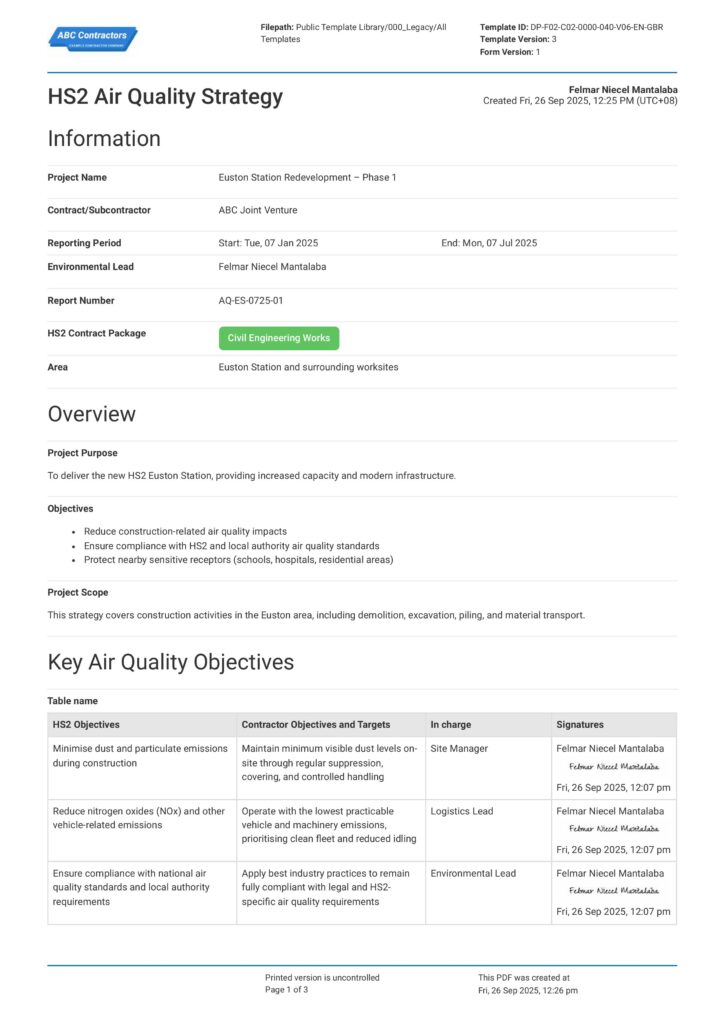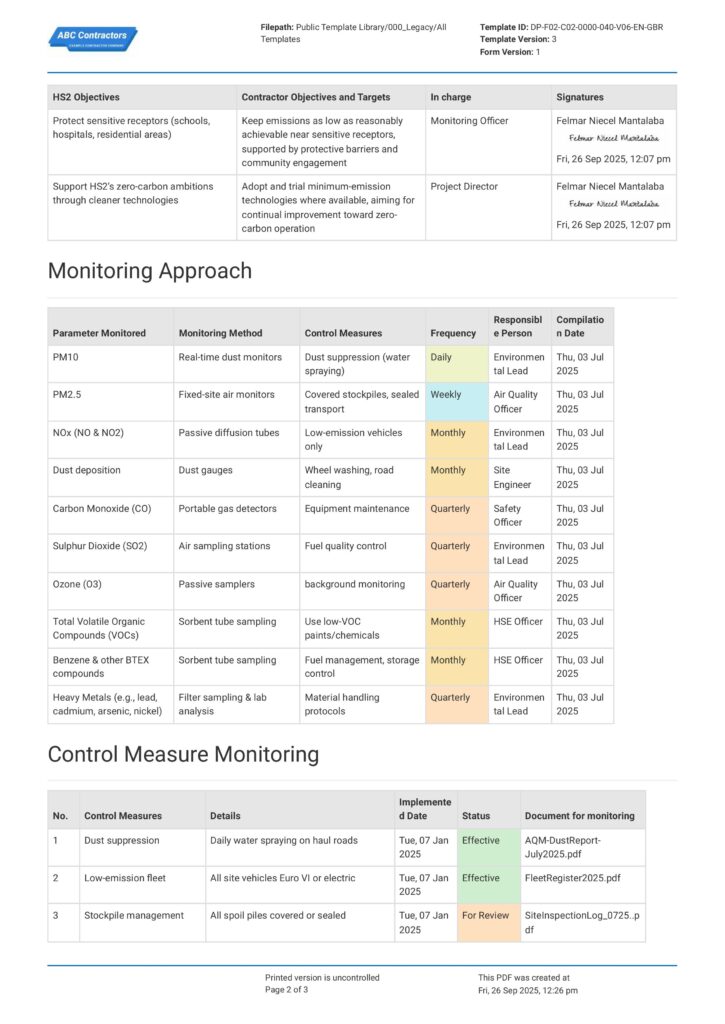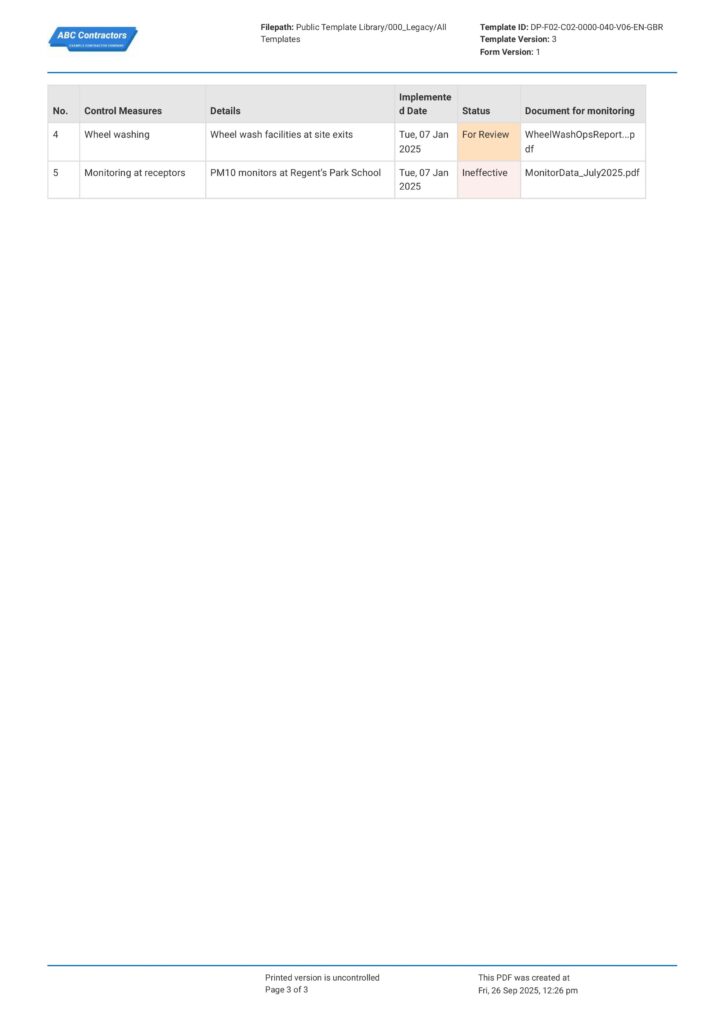HS2 Air Quality Strategy Template
Start with a free 30-day trial. No credit card required.
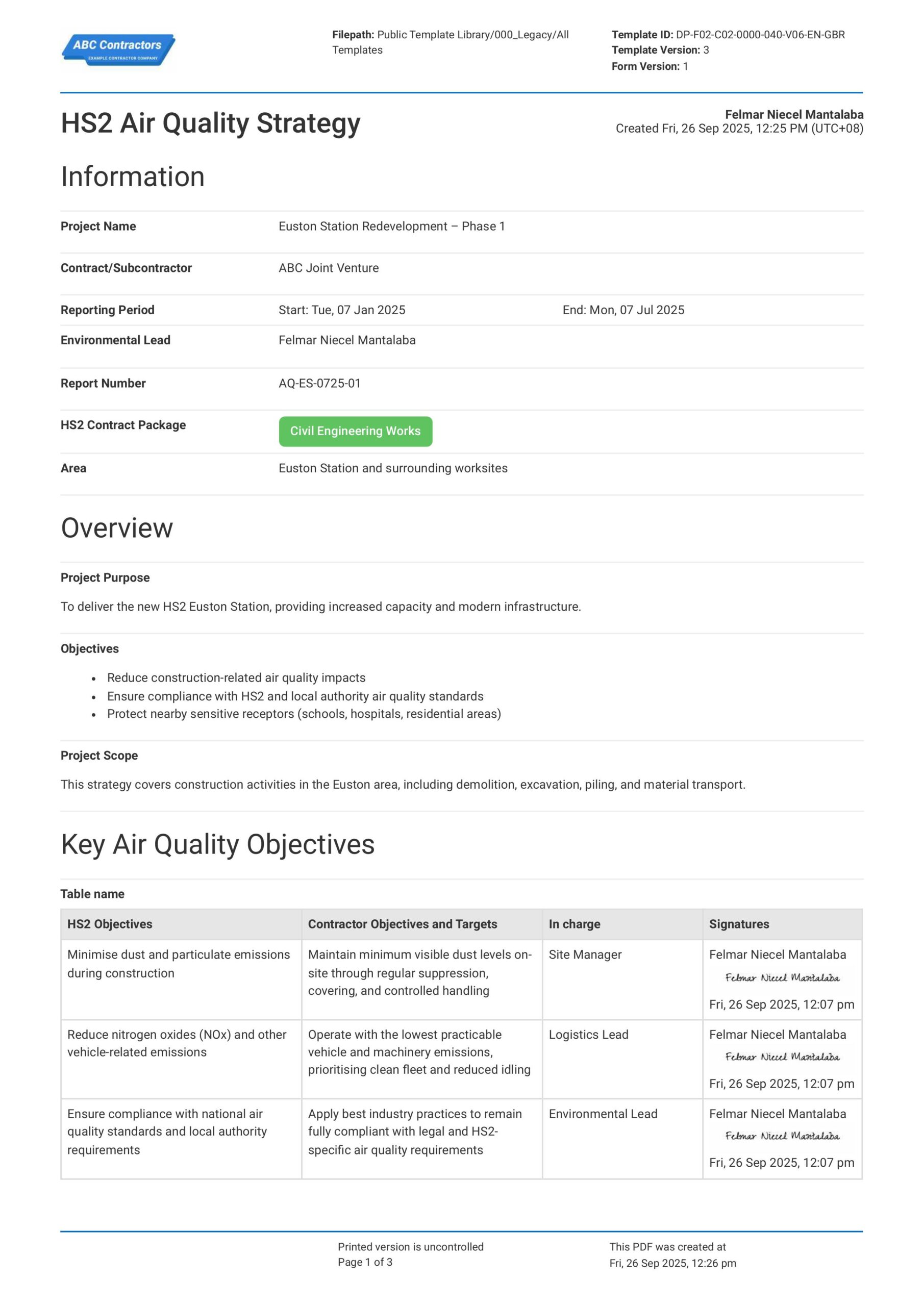
~10,000 employees
~500 employees
~25,000 employees
~20 employees
~50 employees
~1,500 employees
~20 employees
What is an HS2 Air Quality Strategy?
An HS2 Air Quality Strategy is a guide to the HS2 UK project's standards for controlling dust and pollutants during construction, as well as how to define the best efficient methods. This document outlines HS2 Ltd's approach for meeting its sustainability policy on air quality. The sustainability policy prioritizes environmental protection, including pollution prevention and control to preserve air quality.
Compare this HS2 Air Quality Strategy to paper-based forms created from Word, Excel, or PDF
Use this HS2 Air Quality Strategy template for free.
UK Air Quality Standards Regulations & HS2 Compliance
The Air Quality Standards Regulations 201014 implemented Directive 2008/50/EC into national law in England. The Secretary of State for the Environment is responsible for ensuring compliance with air quality limits. In 2015, the UK Supreme Court ordered the UK government to develop strategies to comply with EU limit values (air quality standards) as soon as practicable. The HS2 UK project should align with and lead action plans to meet air quality requirements, serving as an example.
Basis for the UK Air Quality Standards
The WHO's suggested guideline values serve as the basis for the air quality limits set by European legislation and implemented in national law. Because of the long-term impact on health or the natural environment, several pollutants have yearly average concentration limits. Some standards are provided as 24-hour, 1-hour, or 15-minute average concentrations owing to their acute impact on health or the environment. Some contaminants' guidelines include both long-term and short-term concentrations.
HS2 Air Quality Strategy, Key Pollutants and Impacts
Air pollutants are produced by both natural and man-made processes and are discharged into the atmosphere. They may travel vast distances and combine to form new pollutants. Knowing this, creating one of the UK's biggest projects might be rather worrying in terms of air pollution generation. Here are some of the pollutants that we might anticipate during the building of the High Speed 2 Railway:
Particulate matter
PM refers to a combination of solid and liquid particles of varied sizes, shapes, and compositions. PM is defined by aerodynamic size and referred to as coarse particles (PM10, particles smaller than 10 µm in diameter). Fine particles (PM2.5; particles less than 2.5 µm in diameter) Ultrafine particles (PM0.1; particles smaller than 0.1 µm in diameter). The size of the particles and the length of exposure are important predictors of possible harmful health consequences. Particles bigger than 10 µm are often deposited in the nose or throat, but smaller particles offer a higher danger to health due to their ability to penetrate deeper into the lung.
Nitrogen dioxide (NOx)
Nitrogen oxides (NOx) are gases created by the combustion of fossil fuels (e.g., gas, petrol, diesel) in the atmosphere. Road transport accounts for about 50% of total nitrogen oxide emissions. Nitrogen dioxide is hazardous to health, causing shortness of breath and coughing. Nitrogen dioxide causes inflammation in the lungs, lowering immunity to infections, including bronchitis and lung illness. Studies also point to a causal relationship with childhood asthma. Asthmatics are more vulnerable to the negative health consequences of nitrogen dioxide than healthy individuals.
Ammonia (NH3)
Ammonia gas is mostly discharged into the atmosphere from agricultural sources such as slurry, decomposing farm waste, and fertilizer. Once exhaled, ammonia (NH₃) barely lingers in the atmosphere for a few hours. Ammonia pollution in the environment may degrade ecosystems and sensitive habitats over time.
Sulphur dioxide (SO2)
Sulfur dioxide (SO₂) is an acidic gas that combines with water vapor in the atmosphere to form acid rain. Sulfur dioxide is an irritant that may harm the airways, especially in asthmatic patients. Due to significant reductions in industrial emissions, sulphur dioxide (SO₂)no longer poses significant health risks.
Frequently Asked Questions
Why use this HS2 Air Quality Strategy template?
Sitemate's HS2 Air Quality Strategy template is the best way to manage and report on air quality because it’s already trusted by thousands of companies in construction and infrastructure. It’s built to align with HS2’s air quality objectives and industry best practice, and it’s simple enough for anyone on the project team to use quickly and effectively.
Is this template compliant with UK Regulatory standards?
Yes – this template is already aligned with UK regulatory standards, including air quality and environmental requirements. It’s actively used by certified contractors across the construction and infrastructure industry to maintain compliance and meet HS2 project obligations.
Can I edit this HS2 Air Quality Strategy for my project or company?
Yes – the template is fully editable with its simple drag-and-drop functionality – meaning you can have multiple variations of a single template across different projects. Tailor templates to have tables, formulas, sketches, photos, and more. Also tailor it with your company logo and other key structures.
What platforms is the HS2 Air Quality Strategy available in?
This template can be accessed using any device directly on the field like a mobile phone or tablet. Even for team members using the computers have access to this template. Once you're done with data entry, instantly share to team members or export as PDF or CSV when necessary.
Other popular templates you can use and edit for free
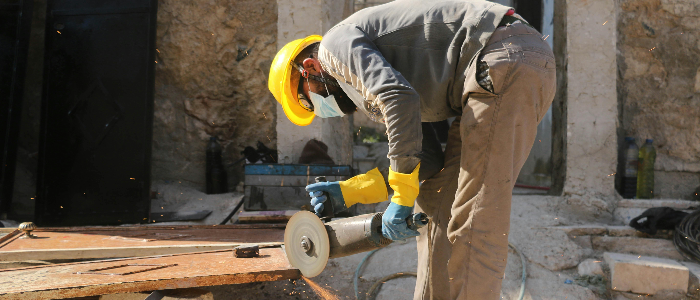
HS2 Air Quality Action Plan
Ensure you have taken the right measures to maintain air quality in HS2 projects.

HS2 Air Quality Strategy
Develop an effective and sustainable strategy to maintain air quality that meets environmental standards for HS2 UK projects.

HS2 Air Quality and Dust Monitoring Report
Easily monitor air quality and dust emissions through smart templates that you can with you on site.
This air quality strategy form was generated with Dashpivot
Establish a workplace that's both healthy and safe. This HS2 Air Quality Strategy is already established to meet HS2 objectives. It contains all the necessary monitoring items to ensure a safe working environment and satisfies all legal requirements in the UK.
- Complete, edit, and review the HS2 Air Quality Strategy from any device.
- Export the HS2 Air Quality Strategy as perfectly formatted PDF documents with your company logo.
- Securely store and manage your Air Quality Strategy for easy searching and finding.
- Track progress automatically and get new insights about performance.
Sitemate builds best-in-class software tools for built world companies.
